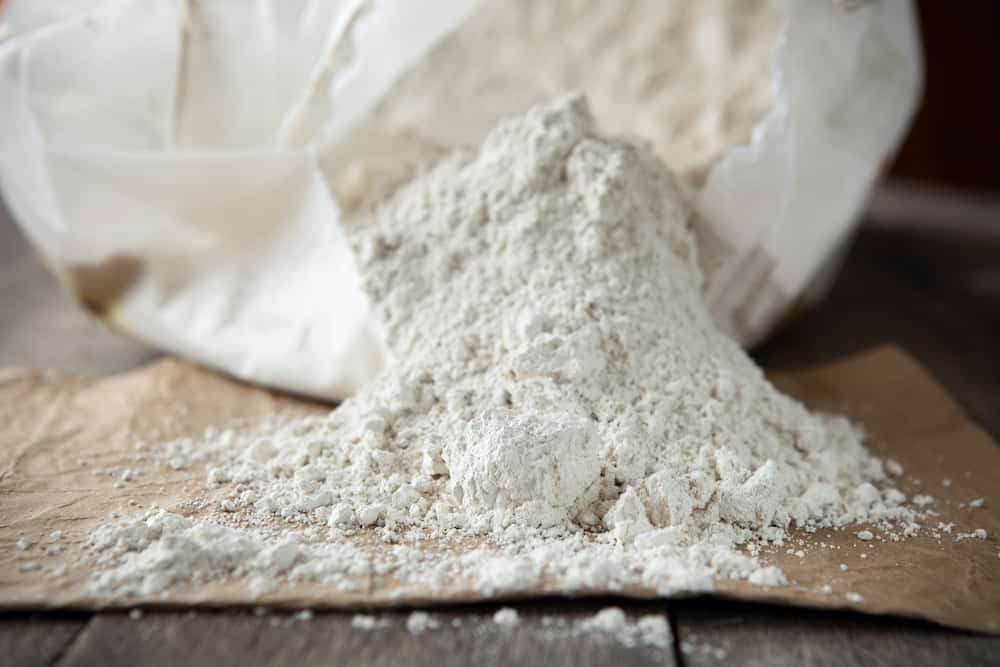Whenever people hear about using diatomaceous earth, they’re always unsure what to do. It’s a gardening secret that is often used as a last resort and is extremely useful.
Diatomaceous earth (DE) is a smooth powder broken down from bone that helps keep bugs and small critters away from your garden. It’s a naturally-occurring, silica-based substance.
As useful as it is, there are precautions when using it — such as wearing protective eye wear — and an effective way of applying it. Please see below for safety information.
As such, today, we’ll help you learn about a few features of DE and how it can assist with your garden crops. We also have some tips on how to use diatomaceous earth in the garden.
What Is Diatomaceous Earth?
The best way we can describe what diatomaceous earth is by breaking down what it’s made out of. Diatomaceous earth, otherwise known as DE, is a rock fossilized with skeletal remains of small single-celled aquatic organisms.
It’s known in the scientific world as the Kieselgur or Kieselguhr. The organism that they use is called a diatom. Diatoms secrete a natural substance, which makes up for 26% of the earth’s crust by weight.
It’s a naturally occurring substance that repels bugs and deters animals from eating it. You can easily ground down this soft rock into a fine powder. Silica, a naturally occurring substance, makes up the remnants of the rock diatoms. It is a mixture of water, oxygen, and remains of fossils.
As a food additive, it can help prevent insects from crawling into the boxes in factories or on the store shelf. It’s not harmful to eat or digest for humans due to our unique digestive system.
However, smaller insects and critters can’t break it down, and their insides will get microtears in them while eating it.
While it may seem harmless to the touch, the powder still has small bones that have sharp edges. When we mean that it’s sharp, we’re not talking about shards of glass. Instead, the finely ground powder contains small razor-like substances on the microscopic level—these work to tear away at the insides of bug’s exoskeleton and digestive tract.
How Does Diatomaceous Earth Chase Away Pests?
The insecticidal effect of diatomaceous earth is profound. DE works by deterring small bugs and critters from eating crops.
The reason for this is that the DE silica skeletons are incredibly sharp on a microscopic level and, when ingested, can cause damage.
For insects, it causes rips in their exoskeleton and dries the insect from the inside out. Thus, working as a natural method as a bug repellent.
On the other hand, it may give larger critters a stomach ache or small tears. This will easily deter them from coming back again. While that may be an effective model for keeping them away from your garden, it may be considered animal cruelty.
As such, it is best to check your current standing laws in your state for what you can and can’t do with wildlife.
Additionally, the white residue left behind from DE can be sprinkled all over your yard, although you will need to begin wearing heavy-duty footwear to prevent any tears.
The residue left will automatically cause critters and bugs to go running in the opposite direction because they won’t be able to pinpoint how they got hurt.
DE is a powerful insect repellent that’s both effective and inexpensive. It works better than leading bug repellents on the market due to its non-toxicity and works on a mechanical level.
On the contrary, other insect repellents rely on their formula to kill insects. If you spray the formula regularly, bugs can build up a natural resistance to it.
For DE, you don’t have to worry about insects building resistance to it. DE works internally to get rid of the bug and doesn’t contain any poisons. It will effectively kill the insect every time you use it.
How to Use Diatomaceous Earth in the Garden
It may seem straightforward on how to apply DE to your garden. That said, we see plenty of gardeners make the same mistake, so we will do our best to walk you through the process of how to use diatomaceous earth in the garden step by step:
- Take the container of DE and inspect it to ensure it’s sealed all around.
- Shake the container roughly to mix the powder well.
- Poke holes into the container that makes it look like a makeshift spice shaker.
- Sprinkle the DE on top of the plants being eaten by pests and insects.
- Only apply to areas of your garden that need it, not everything.
After these steps, you may need to reapply the DE to your garden.
Rainy weather, climate change, and wind may cause some of the DE powder to come off your plants. Reapplying a small amount can help make sure you prevent critters and bugs from getting to your crops.
DE Using Tips
-

how to use diatomaceous earth in the garden
To obtain some DE, you’re going to have to go shopping and look for anything resembling DE food grade. The food-grade powder is very finely ground and is easier to spread around your garden.
Plus, the small particles will be more accessible for small bugs to eat and digest.
If the particles are too big, they may just skip over the DE and head straight to eating your plant.
Once you’ve found this, it can be used effectively against garden pests. Here’s a quick breakdown on a few things you should keep in mind while using DE:
1. Clear Out the Area
Once you get home, you have to clear out an area before you put the DE down. Once the area is clean, begin sprinkling it around the plants you’re trying to prevent damages to.
2. Never Miss a Spot
While placing the DE down, you have to ensure that you don’t miss a spot. Missing one spot could be big enough for critters to get still in.
3. Dust Leaves if Needed
If the pests are eating your garden, then you can dust a few leaves with DE mixed into them, which causes critters to avoid that area.
Do note, though, that you should avoid mixing DE in with plants, flowers, or leaves. This can end up damaging your plants and do more harm than good.
4. Wear Protective Gear
Always make sure that you’re wearing safety eye goggles when dealing with DE. DE can cause some severe damage if it gets into your eye. If you have a dust mask, it is best to put that on so that you’re overly protected.
5. Use It During Dry Conditions
Only use DE in dry conditions. If you live in an area that produces a lot of rainfall, then the DE will just get washed away and placed somewhere else.
With their spikiness in nature, this can cause a lot of harm to neighbors and surrounding animals.
6. Avoid Applying During Windy Days
Do not apply DE onto your crops when there is wind. Even with eye protection, there’s a high risk of it getting into your hair or on your clothing.
This substance may not be fatal, but it can cause some severe damage if you touch your shirt or hair and then rub it into your eye.
Possible Health Effects
Many industries say that using DE is safe, but there are still some warnings that you need to be aware of. Here’s a quick breakdown on when DE is unsafe:
Eye and Respiratory Irritation
Since DE has small shards, we recommend not breathing it in. It may be tempting because of the soft like powder form that it comes in, but it’s an abrasive substance that can be detrimental to your health if you misuse it.
Some side effects include irritation of eyes, nose, lungs, and throat.
Can Be Poisonous When Consumed at High Amounts
DE is non-toxic when eaten in small amounts, which means it won’t cause any poison -like symptoms. Food-grade DE is sometimes called fossil flour.
Manufacturers use it in some cereals to help prevent insects from infesting our food sources. It can also be found in toothpaste and some skincare products. So, it’s safe for consumption but only for low levels.
Skin Irritation
DE may not cut your skin or give you small abrasions, but it will cause your skin to become irritated. Always be fully clothed when applying the DE powder to your plants.
If you get some on your hands or arms, wash it with water right away. To avoid this, consider wearing rubber clothes to help prevent it from getting onto your hands.
Drawbacks to Using DE
One of the major drawbacks of using DE is that it can injure bugs that pollinate flowers in your garden. Bees are often the animals that come and spread their pollen from flower to flower.
They help distribute seeds and give your plants some much-needed nourishment.
The problem with using DE with bees is that the bee will land on your plant and attempt to fertilize using their legs.
Their legs will get tears in them, and eventually, the bee will die.
With bees already going extinct, it’s essential to understand when and where to use DE powder.
What to Do
To help avoid this problem, we’ve talked to a bee expert who recommended a few methods for applying DE powder:
- Only apply a small amount of DE powder to the plants getting infected by insects, not your entire garden.
- Only apply DE early in the morning or in the late afternoon to prevent bees from stepping in it, as they haven’t made their rounds yet.
- Do not apply any DE powder onto plants that you believe bees will pollinate.
- Only use DE near the ground to help reduce the areas of DE where the bees are most likely to land.
As you can see, there is less of a risk for humans than there are for animals.
You’ll be able to apply and use DE around your garden safely.
On that note, it should be applied sparingly, as it could cause problems for animals you’re not targeting.
Diatomaceous Earth is a very effective method
Diatomaceous Earth is a very effective method for removing bugs and small critters from your garden.
It should be used sparingly and only on selected plants that are having problems or being eaten by insects. Other types of repellents may work better if your garden has a full infestation.
Professional gardeners tend to recommend DE as a last resort.
It can be extremely effective at doing what it’s designed to do for your gardens, but we don’t recommend using it every week.
Only use DE when you believe that a plant is struggling to stay alive due to bugs or small critters.
Also, just always wear protective gear when applying DE to your garden.
This includes full body protection to ensure that you’re not getting it on yourself.
If you have any pets or small animals, please keep them away from your garden and consider fencing it off.
This can prevent them from accidentally eating the DE off plants.
Using Diatomaceous Earth
DE is a soft, sedimentary rock made up of silica, a component of the earth’s natural rock, sands, and clay.
It has natural filtration and absorption capabilities.
You can use diatomaceous earth around your property to control insects in vegetable gardens, flower gardens, and in potted plants.
Following the precautions, you can use it in barns, sheds, and stables as well.

